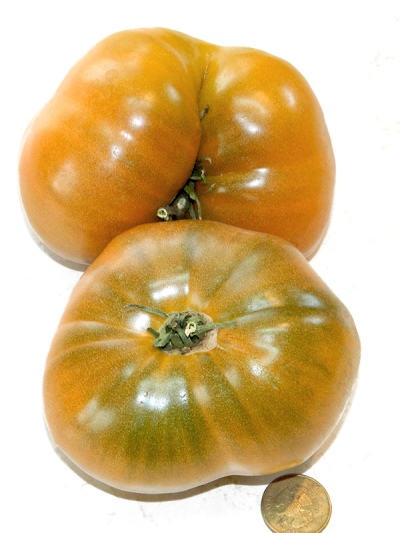
- Authors: Patrina Nuske Small, Australia
- Appeared when crossing: Orange Heirloom x Rosella Purple
- Name synonyms: Dwarf Uluru Ocher, Dwarf Uluru Ocher
- Category: grade
- Growth type: determinant
- Appointment: fresh consumption, for ketchup and tomato paste
- Ripening period: mid-season
- Ripening time, days: 100-110
- Growing conditions: for open ground, for greenhouses
- Bush size: undersized
In the popular collection of standard gnome tomatoes, there are varieties with an exotic unusual color. One of them is the Uluru Okhra variety.
Breeding history
The gnome cultivar Uluru Ocher was created by Patrina Nuske-Small (Australia) as a result of crossing Orange Heirloom and Rosella Purple. Release date: January 2017.
Patrina Nuske Small is a co-founder of the Dwarf Tomato Project. Tomato growers passionate about breeding from all over the world united in 2005 to create new large-fruited varieties with compact bushes from family heirlooms for cultivation in confined spaces (in greenhouses, on balconies, in pots).
The project grew out of communication on an online forum, and Patrina, a speech therapist by education, became its manager for the territories of the Southern Hemisphere. She brought out the first "gnomes" who received the names of the heroes of the story about Snow White. By 2019, the project had created over 120 dwarf varieties.
The variety got its name in honor of Uluru rock, sacred to the Australian aborigines. This unique rock formation in the middle of the desert is composed of iron oxide-rich sandstone and has a rusty orange color.
Description of the variety
Uluru Ocher is a low-growing, mid-season, high-yielding variety from a series of dwarf tomatoes with a bush of determinant growth 50-60 cm high (can reach 120-150 cm) and tasty sweet medium-sized fruits, colored in an ocher-mustard color.
The main qualities of the fruit
Uluru Ocher tomatoes are flat-round, slightly ribbed on top. A feature of the shape is the lush "shoulders", as if dressed in "lantern" sleeves with folds. As it ripens, the hue changes from golden-green to orange-ocher. The stalk may have a brownish-green “blush”.
The skin is dense, does not crack. The flesh of a sunny mustard color is juicy, oily, tender, but fleshy. Small seed chambers are located close to the walls, there are few seeds.
The fruits are quite large, 200-300 g, although there is a wide range in size: from 100 to 400 g. Some gardeners manage to grow even kilogram tomatoes.
Opinions are contradictory about keeping quality, some say that the fruits do not deteriorate, but only wrinkle slightly over time, but most note a short shelf life after being removed from the bush.
Taste characteristics
The taste qualities of the variety deservedly receive the highest marks. Sweet, with bright fruity notes and spices, this tomato is especially good in salads, but also goes for processing into sauces. For whole-fruit canning, it is not the most successful form.
Ripening and fruiting
Uluru Okhra is a mid-season variety, about 100-115 days pass from sowing to the removal of the first batch of ripe fruits. Bushes bear fruit from July to early October.
Yield
An excellent harvest will delight all Uluru Ocher bushes: grown in the open field, greenhouse and potted specimens. Simple brushes with 3-5 ovaries are closely spaced, have short internodes, so the tomatoes hang densely, touching their sides. On a thick, sturdy stem, 3 brushes usually ripen.
2.5-3 kg of fruits are removed from the classic compact plant for gnomes with a height of 50-60 cm, but the bush can be grown even higher, then the weight of the collection reaches 5 kg.
The timing of planting seedlings and planting in the ground
The variety is sown for seedlings in the first half of March. Seedlings sprout together and grow strong and stocky. In May, the seedlings are transferred to a permanent place. The soil for Uluru Ocher should ideally be loose and light. On an open site for a plantation, a well-lit place is chosen.

Growing tomato seedlings is an extremely important process, because it largely depends on whether the gardener will be able to harvest at all. All aspects must be taken into account, from seedbed preparation to planting in the ground.
Landing scheme
Between low-growing bushes Uluru Ocher maintain a distance of 40 cm, between rows 50 cm.When growing a tall bush, a 50 x 60 cm pattern should be used.

Growing and care
The variety does not require special difficulties in care. The only condition for a bountiful harvest of bright, large fruits is a sufficient amount of sunlight. The rest of the agricultural technology is standard: mulching of the root area, regular watering, seasonal feeding.
Most often, the bush is lead in 2-3 stems. Some gardeners grow these standard bushes without pinching, others carry out pinching to the first brush. Due to the large size, the branches require a garter.
Like all representatives of the gnome project, the variety has good immunity to nightshade diseases. Late blight is rarely affected, especially if preventive measures are taken: remove the lower leaves, prevent moisture stagnation.
A wonderful Australian variety fell in love with tomato growers in Russia and every year it is increasingly spreading in various regions of the country.




A plant needs different micronutrients at each stage of growth. All fertilizers can be divided into two groups: mineral and organic. Folk remedies are often used: iodine, yeast, bird droppings, eggshells.
It is important to observe the rate and period of feeding. This also applies to folk remedies and organic fertilizers.



























































































